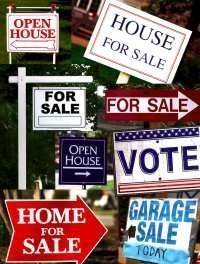
Given the attention that well-managed condominiums pay to preserving architectural integrity and fostering a carefully maintained appearance, it's no wonder that they bristle at the appearance of flamingo lawn ornaments or other outdoor bric-a-brac.
But condos can be challenged by another, thornier, outdoor installation: the For Sale sign.
The Roots of the Problem
Resolving the conundrum of whether or not to permit For Sale signs is complicated by the fact that each of the three parties involved approaches the discussion from a different point of view.
Given today's tight real estate market, sellers understandably feel pressured to do everything they can to make their unit or townhouse stand out from the pack. For this group, the easiest way to achieve that end is to install a For Sale or Open House sign in a prominent location on the front lawn. The signs, after all, garner instant attention from would-be buyers.
From a Realtor's point of view, For Sale signs are mission-critical. The signs advertise not only the property for sale but the Realtor as well, and they offer drive-by contact information. In a tight market, the signs serve a vital function for this group.
While the viewpoint of these first two parties is straightforward, from a condominium's point of view, For Sale signs pose several different problems rather than benefits.
Understand the Community's Point of View
From the community's point of view, says attorney Seth Emmer, partner in Marcus, Errico, Emmer & Brooks in Braintree, Massachusetts, the trouble with For Sale signs is primarily grounded in the community's efforts to control aesthetics and maintain property values.
In his opinion, the signs constitute "visual clutter. They're really no different in many respects than 'yard art.'"
Given that condominiums are vested in maintaining a kempt appearance, he says, both owners and Realtors must understand that "the principle of the ban is grounded in the same thing that governs why the draperies have to be white facing out. It goes to the essence of what the community association is all about. It's about controlling the aesthetics of the condominium's appearance." It was, after all, the carefully maintained appearance of the community that motivated the original purchaser to buy in the first place.
For residents who are not selling their units or townhomes, the introduction of For Sale signs may produce an uncomfortable sense of insecurity, particularly if the unit for sale is vacant, because the signs advertise an available property. This is particularly true if many are available for sale at the same time.
Emmer takes a particularly dim view of For Sale signs being installed when there are many units available: "They can create the problem of an appearance of a fire sale. In some complexes where the majority of units are owned by investor purchasers, every other unit may have a sign in the window. Pragmatically, it can affect value."
In gated or limited-access communities, he sees even less value to the signs. "In many communities," he says, "there's limited access to the community, so what's the need for a sign? It's not like the public is going to be driving around the condominium looking for property."
Dispensing the Information
According to Emmer, the no-sign rule is pervasive in the New England communities with which he and his partners work. But Emmer notes that there is a quick, easy, and inexpensive solution to the problem. "If there is a bulletin board or some other common area where For Sale signs or flyers could be displayed, that would make sense," he says. "Then the Board could come up with some rule for that."
If the board was willing to consider allowing the signs, he says, it could require that the signs adhere to a particular appearance. By dictating style, he says, the board can exert some control over what is posted. "If they want to allow them," says Emmer, "they can regulate size, color, and placement."
Communities that do not permit freestanding signs oftentimes do offer other vehicles for owners to advertise units for sale. The key to these other vehicles is discretion. The Village at Maplewood, in Bethlehem, New Hampshire, for instance, maintains an active community Web site. Although most of the site is dedicated to community business, and therefore behind a firewall, it also includes a public section devoted to units for sale.
Justin Gargiulo, CPM, a property manager with Great North Property Management in Peabody, Massachusetts, is a firm believer in the Web as the sales tool of choice. "Ninety-five percent of the communities we manage don't allow any sort of signage. That includes signage in the windows, including For Sale by Owner signs. "
Gargiulo advocates for the Internet as the sales tool of choice. "In today's real estate world, so many people are listing on-line, and you've pretty much seen the place before you walk into it. If people are going look for a condominium, they turn to the Web."
In the end, owners, trustees, managers and Realtors must take an understanding attitude toward the boards entrusted with running communities smoothly and protecting property values. "It comes down to where you draw the lines," says Emmer. "Something you may not see as noxious in one set of circumstances can be a problem when the circumstances change slightly. Boards tend to opt for No because it eliminates the problem of how to draw lines."
"The general consensus in most associations I know of," he says, "is not to allow For Sale signs."



Leave a Comment